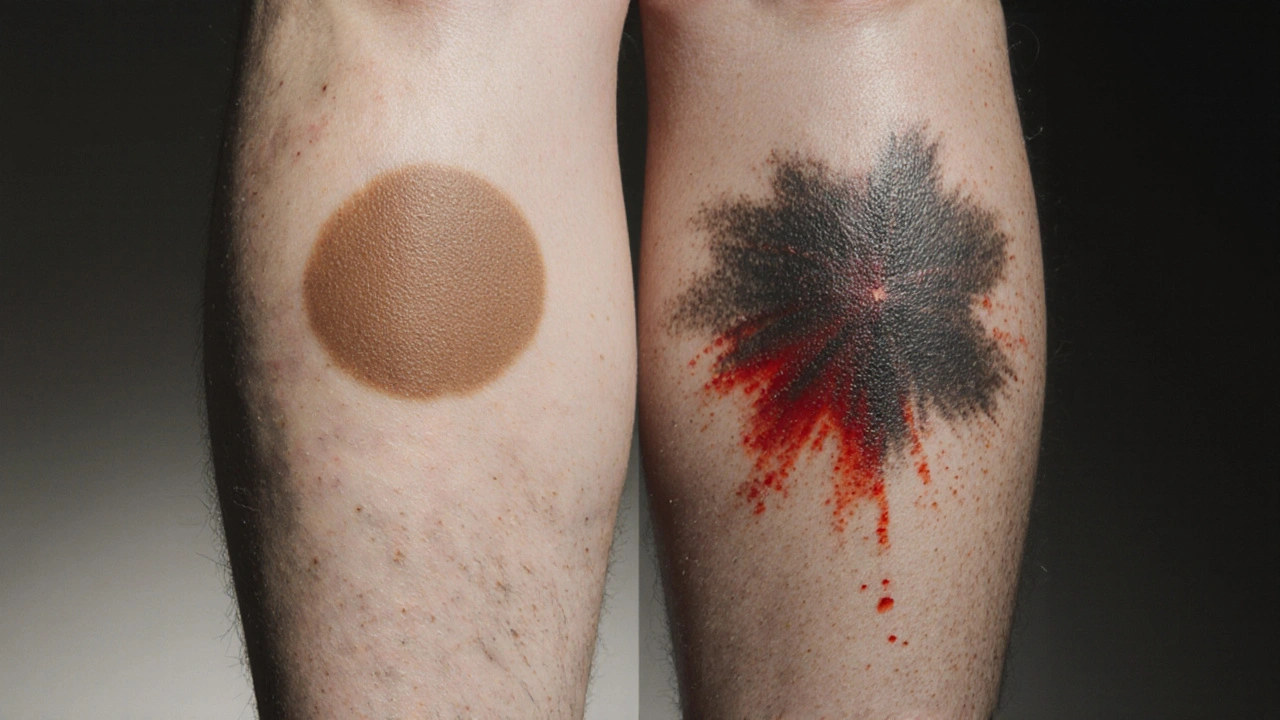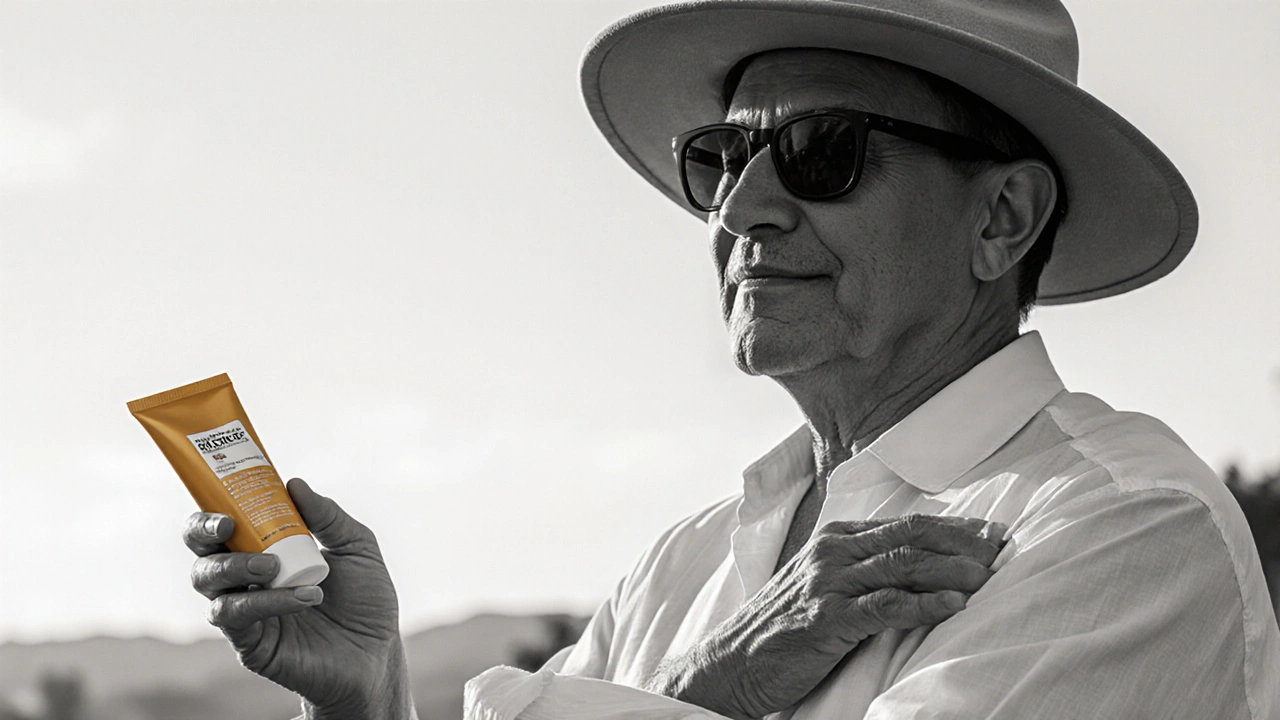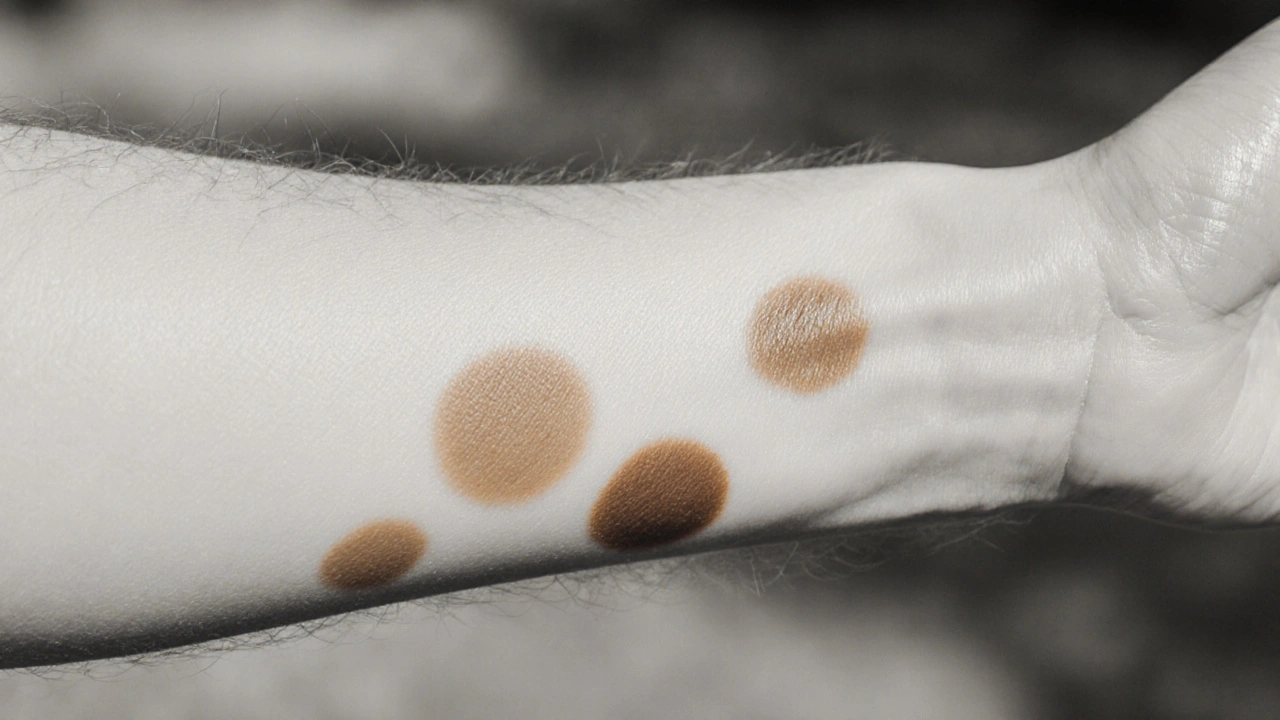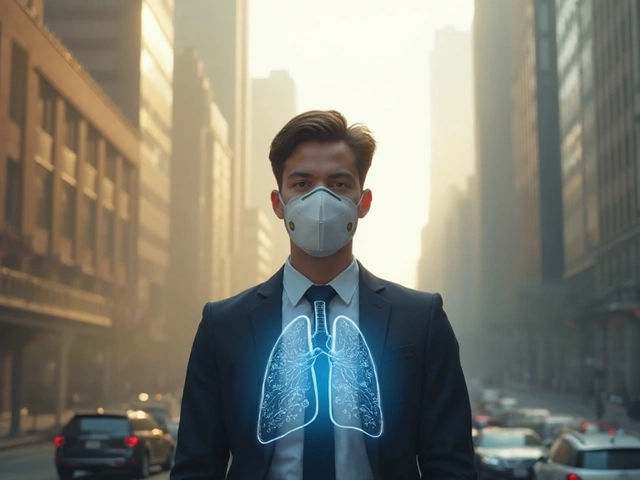Skin Spot Assessment Tool
ABCDE Skin Cancer Assessment
Use this tool to check if your skin spot shows warning signs of skin cancer. This assessment uses the standard ABCDE criteria recommended by dermatologists.
When you notice age spots are flat, brownish patches that appear on sun‑exposed skin, usually after the age of 40, it’s easy to assume they’re harmless. They’re also called solar lentigines or liver spots, and they result from years of UV exposure causing extra melanin production.
What Exactly Are Age Spots?
Age spots, medically known as solar lentigines, are benign pigmented lesions. Their color ranges from light tan to deep brown, and they’re typically 2‑10mm in diameter. Because they don’t change much over time, most dermatologists consider them a sign of chronic sun damage rather than a disease.
How Do Age Spots Differ From Skin Cancer?
Skin cancer is a group of malignant growths that arise from skin cells. The three most common types are melanoma, basal cell carcinoma (BCC), and squamous cell carcinoma (SCC). While age spots stay flat and uniform, cancerous lesions often evolve rapidly, become raised, bleed, or itch.
| Feature | Age Spots (Solar Lentigines) | Melanoma | Basal Cell Carcinoma | Squamous Cell Carcinoma |
|---|---|---|---|---|
| Shape | Round, flat | Irregular, often asymmetrical | Round or oval, may have a raised center | Scaly, may be crusty |
| Color | Uniform brown | Varies: brown, black, blue, red, white | Pink, pearly, or translucent | Red, pink, or brown |
| Growth Rate | Very slow, years | Rapid change in size or shape | Slow but can enlarge over months | May ulcerate within months |
| Symptoms | Usually none | Itching, bleeding, new mole | Bleeding, crusting | Pain, crusting, non‑healing sore |
| Medical Action | Cosmetic removal optional | Immediate biopsy & treatment | Biopsy & excision recommended | Biopsy & possible surgery |
Risk Factors That Link Both Conditions
The common thread is ultraviolet (UV) radiation. People with high Fitzpatrick skin types I‑II (very fair skin that burns easily) are especially vulnerable. Other contributors include:
- Lifetime sun exposure - outdoor work, beach vacations, or tanning beds.
- Genetic predisposition - family history of melanoma.
- Age - both age spots and skin cancer prevalence rise after 40.
- Immune suppression - organ‑transplant patients have higher rates of SCC.

When Should You See a Dermatologist?
Follow the ABCDE rule for melanomas:
- Asymmetry - one half doesn’t match the other.
- Border - irregular, scalloped, or blurred edges.
- Color - multiple shades within one spot.
- Diameter - larger than 6mm (about the size of a pencil eraser).
- Evolution - any change in size, shape, or symptoms.
Prevention Strategies to Keep Both at Bay
Prevention is a two‑step game: limit UV exposure and boost skin health.
- Apply broad‑spectrum sunscreen with SPF30 or higher every morning, even on cloudy days. Reapply every two hours or after swimming.
- Wear protective clothing - wide‑brimmed hats, UV‑blocking sunglasses, and long‑sleeve shirts.
- Seek shade between 10a.m. and 4p.m., when UV intensity peaks.
- Avoid indoor tanning devices; they emit UVA and UVB rays similar to the sun.
- Incorporate antioxidants (vitaminC, green tea) into your diet to help skin repair DNA damage.
Treatment Options for Age Spots
If age spots bother you cosmetically, several safe methods are available:
- Chemical peels - glycolic or trichloroacetic acid loosens pigmented cells.
- Laser therapy - Q‑switched lasers target melanin without harming surrounding tissue.
- Intense pulsed light (IPL) - broadband light breaks down excess pigment.
- Topical agents - hydroquinone, retinoids, or azelaic acid can fade spots over weeks.

What If a Spot Turns Out to Be Cancerous?
Early detection dramatically improves outcomes. If a biopsy confirms melanoma, treatment may involve surgical excision, sentinel lymph node analysis, and possibly immunotherapy (e.g., pembrolizumab). For BCC or SCC, removal is often curative, though advanced cases might need Mohs micrographic surgery or radiation.
Quick Takeaways
- Age spots are harmless pigment patches caused by long‑term sun exposure.
- Skin cancer lesions change quickly, may bleed, and often feel rough or itchy.
- Use the ABCDE rule to spot warning signs.
- Daily broad‑spectrum SPF30+ sunscreen and protective clothing reduce risk.
- See a dermatologist for any new, changing, or symptomatic spot.
Frequently Asked Questions
Can age spots turn into skin cancer?
Age spots themselves are not precancerous, but both share the same cause-UV damage. If a spot starts changing in size, shape, or color, it should be evaluated because it could be a separate lesion like melanoma.
How often should I perform a self‑skin exam?
Aim for a full-body check once a month. Use a mirror for hard‑to‑see areas and ask a partner to look at the back of your neck, scalp, and between toes.
Is sunscreen enough to prevent age spots?
Sunscreen is the cornerstone, but combining it with hats, clothing, and avoiding peak sun hours offers the best protection. Even on cloudy days, up to 80% of UV rays can reach your skin.
What does a dermatologist do during a skin check?
The doctor inspects lesions with the naked eye and often uses a dermatoscope-a magnifying lens with polarized light-to evaluate pigment patterns. If something looks suspicious, a shave or punch biopsy is taken for lab analysis.
Are there home remedies that really fade age spots?
Topical vitaminC serums and over‑the‑counter hydroquinone can lighten spots gradually, but results are modest compared to professional laser or chemical peel treatments. Consistent sunscreen use remains the most effective long‑term strategy.







Stay sun safe, folks!
Hey all, just wanted to add that the ABCDE rule is a solid clinical framework for flagging potential melanomas. It’s not just about size; asymmetry and border irregularities are red flags. Also, broad‑spectrum SPF30+ should be part of daily routine, even on cloudy days, because up to 80% of UV rays penetrate clouds. Consistent re‑application every two hours, especially after swimming or sweating, maximizes protection. For those with fair skin (Fitzpatrick I‑II), consider a physical blocker like zinc oxide for added defense. Remember, sunscreen is only one layer; hats, UV‑blocking clothing, and sunglasses complete the shield. Lastly, if you notice any change in an existing spot-color shift, elevation, or itching-schedule a dermatologist visit promptly.
Honestly, the U.S. has the best dermatology resources, but many still ignore the sun’s wrath. It’s like we’re proud of our beach culture while letting UV damage run rampant. Let’s all step up, wear those hats, and stop pretending the sun won’t catch us.
UV protection is non‑negotiable.
Another snooze‑fest post about spots - yawn.
Great rundown! 🌞 Remember, a quick self‑check each month can catch changes early. Keep that sunscreen handy! 😊
Absolutely, Melissa! Consistency is key-apply sunscreen like you would brush your teeth. 🙂
While the article dutifully enumerates the dermal dichotomy between lentigines and malignancies, it scarcely grazes the epistemological underpinnings of photobiology. One might argue that a mere tabular juxtaposition belies the intricate photochemical cascades driving melanocyte dysregulation. Moreover, the lexical simplicity employed here could be supplanted by a more sesquipedalian lexicon, thereby elevating the discourse to a salon-worthy symposium.
First off, I appreciate the thoroughness of the guide – it hits most of the practical points anyone concerned about skin health needs to know.
Let’s break down the core takeaways.
Age spots, or solar lentigines, are essentially harmless accumulations of melanin due to chronic UV exposure. They’re flat, uniform in color, and evolve at a glacial pace, often over years.
Contrast that with melanoma, basal cell carcinoma, and squamous cell carcinoma. Those lesions can change dramatically within weeks, become raised, bleed, itch, or develop an irregular border.
The ABCDE rule is your frontline diagnostic checklist: Asymmetry, Border irregularity, Color variation, Diameter over 6 mm, and Evolution over time. If any of those criteria ring true for a lesion, a dermatologist should see it immediately.
Speaking of dermatologists, a quick dermatoscopic exam can differentiate a benign lentigo from an early melanoma with high accuracy. It’s a painless, in‑office procedure that often saves lives by catching malignancies before they metastasize.
Prevention is where most of us can make a real impact. Broad‑spectrum SPF 30+ sunscreen should be a daily habit, rain or shine. Reapply every two hours, and definitely after swimming or sweating. Pair that with physical barriers: wide‑brimmed hats, UV‑blocking sunglasses, and long‑sleeve shirts made from tightly woven fabrics.
Don’t forget the timing – the sun’s UV index peaks between 10 a.m. and 4 p.m. Whenever possible, stay in the shade during those hours.
And for those who love a tan, indoor tanning beds are a myth‑wrapped hazard; they emit UVA and UVB rays that can be just as damaging, if not more so, than natural sunlight.
If you’re already dealing with age spots and want them faded for cosmetic reasons, you have options: chemical peels (glycolic or TCA), laser therapy, IPL, or topical agents like hydroquinone and retinoids. All should be performed under professional supervision to minimize scarring or pigment changes.
Finally, if a spot does turn out to be cancerous, early detection vastly improves outcomes. Melanoma may require surgery, sentinel lymph node biopsy, and possibly immunotherapy. BCC and SCC are generally curable with excision, though advanced cases might need Mohs surgery or radiation.
Bottom line: Sunscreen, protective clothing, regular self‑exams, and prompt dermatologist visits are the trifecta for keeping both age spots and skin cancer at bay. Stay vigilant, stay protected, and don’t shy away from professional advice when something feels off.
Honestly, I think big pharma wants us all scared of “spots” so they can sell more “miracle creams”. The whole sunscreen narrative feels like a marketing ploy. Still, I guess checking your skin weekly isn’t the worst habit.
While I concur with the factual accuracy of the presented information, I would like to commend the author for maintaining a commendable level of conciseness. The inclusion of the ABCDE mnemonic, in particular, exemplifies an effective pedagogical tool for laypersons. Moreover, the recommended prevention strategies align with current dermatological consensus. Nonetheless, future discourse could benefit from a deeper exploration of photoprotection mechanisms at the molecular level.
Wow, another “stay safe” spiel. As if the sun is the only villain out there. Have you considered that stress and diet might be equally culpable? This is just another echo chamber.
We are all but shadows dancing on the skin of existence, and these so‑called “age spots” are merely the universe’s graffiti on our epidermal canvas. Yet, the fleeting nature of our awareness often blinds us to the deeper metaphysical implications of UV radiation.
Honestly, if you’re relying on sunscreen alone, you’re living in a fantasy. The real problem is western media’s obsession with vanity. Stop feeding that hype and start questioning who profits from your fear.
ucsume? idk lol u r right but sunscreen is just hype, i think just wear hats lol